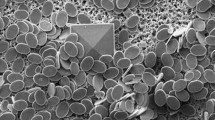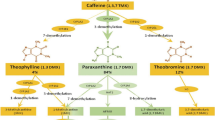Abstract
Objective
To investigate the impact of green tea on urinary oxalate excretion in healthy male volunteers.
Materials and methods
The oxalate concentrations after different brewing times (2–60 min) of different qualities (2–8 g) of green tea were measured in in vitro experiment. In in vivo experiment, the effects on urine composition were assessed in 12 healthy men with an age of 24–29 years. Each subject was requested to collect two 24-h urine samples under normal dietary conditions. Green tea prepared from tea bags containing 2 g of tea leafs was consumed by the subjects for 7 consecutive days, and 24-h urine samples were collected and analyzed on days 6 and 7. After 3-week washout interval, all subjects consumed green tea containing 4 g of leaf tea for another 7 consecutive days. Two 24-h urine samples were collected on the last 2 days. Urine volume, pH, calcium, magnesium, sodium, phosphate, potassium, chloride, citrate, oxalate, urate and creatinine were measured.
Results
In the in vitro experiments, oxalate in solution increased with brewing time (p < 0.05) and tea quality (p < 0.05). In the in vivo experiment, 24-h urinary oxalate increased significantly (0.24 ± 0.09 mmol to 0.32 ± 0.13 mmol, p = 0.045) when tea was prepared from 2-g bags of green leaf tea. Consumption of green tea containing 4 g of leaf tea resulted in 24-h urinary oxalate increase (0.25 ± 0.25 mmol to 0.34 ± 0.22 mmol, p = 0.041).
Conclusions
In vitro studies showed that there was a gradual increase in solution concentrations of oxalate that was associated with increased brewing time and increased quality of green tea. Studies in normal men showed that green tea consumption was associated with increased urinary exertion of oxalate.
Similar content being viewed by others
References
Moe OW (2006) Kidney stones: pathophysiology and medical management. Lancet 367:333–344
Hesse A, Siener R (1997) Current aspects of epidemiology and nutrition in urinary stone disease. World J Urol 15(3):165–171
Thamilselvan S, Khan SR, Menon M (2003) Oxalate and calcium oxalate mediated free radical toxicity in renal epithelial cells: effect of antioxidants. Urol Res 31(1):3–9
Thamilselvan V, Menon M, Thamilselvan S et al (2014) Oxalate at physiological urine concentrations induces oxidative injury in renal epithelial cells: effect of α-tocopherol and ascorbic acid. BJU Int 114(1):140–150
Gasińska A, Gajewska D (2007) Tea and coffee as the main sources of oxalate in diets of patients with kidney oxalate stones. Rocz Panstw Zakl Hig 58(1):61–67
Itoh Y, Yasui T, Okada A et al (2005) Preventive effects of green tea on renal stone formation and the role of oxidative stress in nephrolithiasis. J Urol 173(1):271–275
Jeong BC, Kim BS, Kim JI et al (2006) Effects of green tea on urinary stone formation: an in vivo and in vitro study. J Endourol 20(5):356–361
Rodgers A, Mokoena M, Durbach I et al (2016) Do teas rich in antioxidants reduce the physicochemical and peroxidative risk factors for calcium oxalate nephrolithiasis in humans? Pilot studies with Rooibos herbal tea and Japanese green tea. Urolithiasis 44:299–310
Wu W, Yang D, Tiselius HG et al (2014) The characteristics of the stone and urine composition in Chinese stone formers: primary report of a single-center results. Urology 83(4):732–737
Wu W, Yang D, Tiselius HG et al (2015) Collection and storage of urine specimens for measurement of urolithiasis risk factors. Urology 85(2):299–303
Tiselius HG (2002) Medical evaluation of nephrolithiasis. Endocrinol Metab Clin North Am 31:1031–1050
Hönow R, Gu KL, Hesse A et al (2010) Oxalate content of green tea of different origin, quality, preparation and time of harvest. Urol Res 38(5):377–381
Lotfi Yagin N, Mahdavi R, Nikniaz Z et al (2012) Oxalate content of different drinkable dilutions of tea infusions after different brewing times. Health Promot Perspect 2(2):218–222
Mahdavi R, Lotfi Yagin N, Liebman M et al (2013) Effect of different brewing times on soluble oxalate content of loose-packed black teas and tea bags. Urolithiasis 41(1):15–19
Finch AM, Kasidas GP, Rose GA et al (1981) Urine composition in normal subjects after oral ingestion of oxalate-rich foods. Clin Sci (Lond) 60(4):411–4188
McKay DW, Seviour JP, Comerford A et al (1995) Herbal tea: an alternative to regular tea for those who form calcium oxalate stones. J Am Diet Assoc 95(3):360–361
Syed F, Mena-Gutierrez A, Ghaffar U (2015) A case of iced-tea nephropathy. N Engl J Med 372(14):1377–1378
Robertson WG, Hughes H et al (1993) Importance of mild hyperoxaluria in the pathogene-sis of urolithiasis. Scanning Microsc 7(1):391–401
Scheid C, Hari K, Menon M (1996) Oxalate toxicity in LLC-PK1 cells: role of free radicals. Kidney Int 49:413
Tiselius HG, Ackermann D, Alken P et al (2001) Guidelines on urolithiasis. Eur Urol 40(4):362–371
Funding
This work was financed by grants from the National Natural Science Foundation of China (No. 81570633), and Science and Technology Project in Guangzhou (Nos. 201604020001, 201607010359).
Author information
Authors and Affiliations
Corresponding author
Ethics declarations
Conflict of interest
The authors declare that they have no conflict of interest. All authors of this article declare that they have no conflict of interest with company producing the green tea bags.
Ethical approval
All procedures performed in studies involving human participants were in accordance with the ethical standards of the institutional and/or national research committee and with the 1964 Helsinki Declaration and its later amendments or comparable ethical standards.
Informed consent
Informed consent was obtained from all individual participants included in the study.
Rights and permissions
About this article
Cite this article
Chen, K., Chen, D., Lan, C. et al. Does green tea consumption increase urinary oxalate excretion? Results of a prospective trial in healthy men. Int Urol Nephrol 50, 29–33 (2018). https://doi.org/10.1007/s11255-017-1720-x
Received:
Accepted:
Published:
Issue Date:
DOI: https://doi.org/10.1007/s11255-017-1720-x




